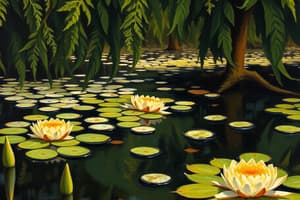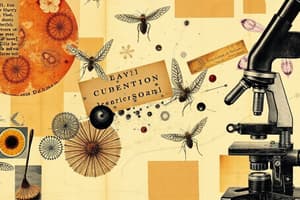Podcast
Questions and Answers
What is the primary purpose of observation in scientific research?
What is the primary purpose of observation in scientific research?
- To eliminate subjective interpretations
- To formulate theories without testing
- To gather information about phenomena (correct)
- To prove established theories
Which statement is true regarding indirect observation?
Which statement is true regarding indirect observation?
- It uses instruments to gather data. (correct)
- It produces only qualitative data.
- It relies solely on visual inspection.
- It is less reliable than direct observation.
Which of the following best describes qualitative descriptions?
Which of the following best describes qualitative descriptions?
- Descriptions focused entirely on counts.
- Descriptions that indicate physical properties using words. (correct)
- Descriptions that require precise measurements.
- Descriptions using only numerical values.
Why are well-established scientific theories sometimes modified or discarded?
Why are well-established scientific theories sometimes modified or discarded?
What distinguishes quantitative descriptions from qualitative ones?
What distinguishes quantitative descriptions from qualitative ones?
What role does observation play at the beginning of the scientific method?
What role does observation play at the beginning of the scientific method?
Which of the following examples illustrates the use of both qualitative and quantitative observations?
Which of the following examples illustrates the use of both qualitative and quantitative observations?
What is meant by 'scientific truth' in the context of observation?
What is meant by 'scientific truth' in the context of observation?
What is the primary goal of practicing observation in this exercise?
What is the primary goal of practicing observation in this exercise?
Which of the following describes a key difference between qualitative and quantitative observations?
Which of the following describes a key difference between qualitative and quantitative observations?
What is a suggested activity to aid in writing observations for the fish and plant?
What is a suggested activity to aid in writing observations for the fish and plant?
What type of descriptions should be avoided when making observations?
What type of descriptions should be avoided when making observations?
Which scenario involves observing fish behavior after a distraction?
Which scenario involves observing fish behavior after a distraction?
In the activity involving verbs associated with fish and human behavior, what should students do?
In the activity involving verbs associated with fish and human behavior, what should students do?
What is one common aspect of observations that students are encouraged to assess?
What is one common aspect of observations that students are encouraged to assess?
What is a critical component in synthesizing observations into accurate descriptions?
What is a critical component in synthesizing observations into accurate descriptions?
What is a key difference between how fish and humans swim?
What is a key difference between how fish and humans swim?
What is the first action typically taken by a person when swimming?
What is the first action typically taken by a person when swimming?
Which behavior is common between fish and humans?
Which behavior is common between fish and humans?
What is the reaction of the 'makahiya' plant to stimuli?
What is the reaction of the 'makahiya' plant to stimuli?
Which characteristic of life is NOT demonstrated by the 'makahiya' plant and fish behavior?
Which characteristic of life is NOT demonstrated by the 'makahiya' plant and fish behavior?
What is the primary purpose of the course material mentioned?
What is the primary purpose of the course material mentioned?
What are preliminary qualitative observations of the 'makahiya' plant?
What are preliminary qualitative observations of the 'makahiya' plant?
Which of the following activities involves observing a plant?
Which of the following activities involves observing a plant?
What might a scientific question regarding the 'makahiya' plant be?
What might a scientific question regarding the 'makahiya' plant be?
In what way do fish and plants like 'makahiya' differ in their typical survival strategies?
In what way do fish and plants like 'makahiya' differ in their typical survival strategies?
What is prohibited regarding the course material?
What is prohibited regarding the course material?
Which type of scientific observation is being practiced in Activity 1?
Which type of scientific observation is being practiced in Activity 1?
What kind of questions are students expected to formulate from their observations?
What kind of questions are students expected to formulate from their observations?
What is the role of the Genetics and Molecular Biology Division mentioned?
What is the role of the Genetics and Molecular Biology Division mentioned?
Which aspect of the course is highlighted in the given content?
Which aspect of the course is highlighted in the given content?
In which academic course is this material utilized?
In which academic course is this material utilized?
What is a key characteristic of effective observations?
What is a key characteristic of effective observations?
Which of the following methods can be used to record initial observations?
Which of the following methods can be used to record initial observations?
What type of observations are particularly useful in understanding biochemical transformations within cells?
What type of observations are particularly useful in understanding biochemical transformations within cells?
What can result from observing various students during a dissection exercise?
What can result from observing various students during a dissection exercise?
Why might a camera flash be problematic during wildlife observations?
Why might a camera flash be problematic during wildlife observations?
Which of the following is crucial for developing observational skills?
Which of the following is crucial for developing observational skills?
What type of recording is particularly useful for capturing details of fast action sequences?
What type of recording is particularly useful for capturing details of fast action sequences?
Which of the following methods can improve the clarity of observational descriptions?
Which of the following methods can improve the clarity of observational descriptions?
Flashcards are hidden until you start studying
Study Notes
Observation in Scientific Research
- Observation is critical in gathering information about activities, processes, and structures, employing all five senses.
- Both direct and indirect observations are essential; indirect observations utilize instruments to gather data.
- Accurate observation is foundational in scientific research, guiding the identification of problems.
Importance of Observation
- Observational data can lead to the formulation of hypotheses about natural phenomena.
- Historical beliefs, such as Ptolemy’s geocentric theory and spontaneous generation, were based on observations but later disproven by more rigorous methods.
- Scientific knowledge is tentative and subject to change with new evidence.
Types of Observations
- Observations can be qualitative (descriptive) or quantitative (numerical).
- Qualitative descriptions relate to characteristics like color or shape, while quantitative involves measurements and counts.
- Both types can be combined based on the experimental objective.
Recording Observations
- Initial observations can be recorded through paragraphs or imagery, such as photos or videos.
- Important to avoid drawing biases or making interpretations during observation.
- In laboratory settings, anatomical drawings, diagrams, and charts aid in precision and clarity.
Laboratory Activities
- The exercise includes observing fish behavior under various conditions: undisturbed, after pebble drops, food drops, and tapping the tank.
- The “makahiya” plant’s response to stimuli is also observed, emphasizing its unique traits.
- Students are encouraged to express their observations in clear, well-structured sentences.
Learning Outcomes
- Differentiate between qualitative and quantitative observations.
- Develop skills to synthesize observations into accurate descriptions.
- Evaluate potential biases influencing observational data.
Practical Applications
- Activities involve drawing and labeling anatomy, listing expected behavioral verbs, and observing environmental interactions.
- Questions encourage deeper thinking about similarities and differences between behaviors of fish and humans.
- Understanding the mechanistic responses of the “makahiya” plant serves as an investigative challenge.
Suggested Resources
- Utilize online resources to enhance observation skills and knowledge on scientific observation.
Student Engagement
- Students are reminded to keep a notebook for recording observations and to think critically about the characteristics of life demonstrated during activities.
Studying That Suits You
Use AI to generate personalized quizzes and flashcards to suit your learning preferences.




